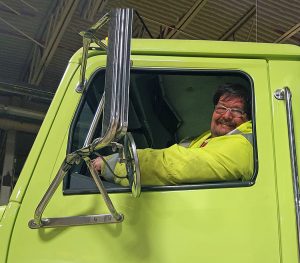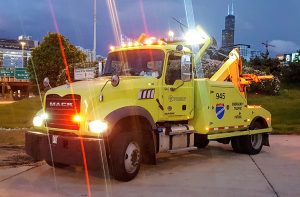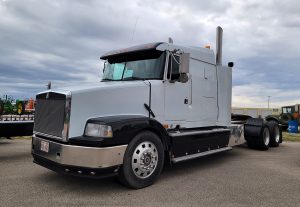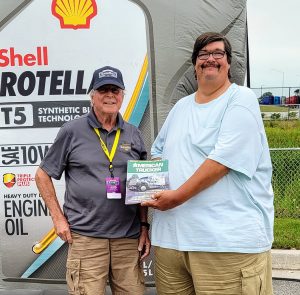
This month we want to introduce you all to our friend Sean Huber – a true highway helper – literally. John met Sean at the Mid-America Truck Show in 2012, and then I met him in 2016. Sean, among many other things, is an amateur photographer who has a huge collection of truck photos from the shows he has attended over the past 30 years. He first started taking pictures as a way for him to help remember all the trucks. He currently has over 42,000 pictures on his Flickr page organized by show or event and the year. You can look up “Sean’s Truck and Machinery Pictures” on Flickr or clink the link here. He has always enjoyed looking at other people’s pictures, so he thought he would start sharing his photos, as well.
As we got to know Sean, we learned he has a great story about how he came to love and drive a truck, and how he got into photographing trucks. He was born in and grew up in Chicago, and his mom said that his fascination with trucks began before he even began talking. There is no one else in his family that has any connection to trucks. When Sean was about 11, his mom got him a subscription to American Trucker, a magazine that our friend Bette Garber was writing for in 1990 when I first met her. Another writer for the magazine at the time was Steve Sturgess, and two years ago, Sean had the opportunity to have Steve autograph one of his copies of American Trucker at Shell SuperRigs in Hampshire, IL. Sean was beyond thrilled to meet Steve and talk to him for a while. Steve was a well know trucking writer who sadly passed away not too long ago on September 24, 2022.
Growing up, Sean was the kid doing the arm pump to truckers, and his truck magazine subscription grew to not only include American magazines, but trucking magazines from other countries, as well. Listening to Sean and our very own Truckapedia author Mark Harter talk about these publications and the trucks in them, on one of our party line conversations, was educational, to say the least. Today, Sean has books and magazines from 11 different countries.
Attending truck driving school in 1999, Sean got his CDL thanks to CRST out of Cedar Rapids, IA and was all set to start the job he had dreamed of his whole life. Getting out on the road and seeing all the places was great, but after being out there for about nine months, he wanted to go home. He learned early on that the over the road life was not going to be his path. He stuck out the year he was committed to and then went home. Sean told us he has no regrets about that year – had he not done it, he would have always wondered, “What if?” Today, he knows the answer to that question, and peace comes with knowing, but he still jokes that trucking, “Chewed me up and spit me out.”
Today, Sean has what he calls his hobby truck. This truck does not earn its keep and is registered as an antique. It’s a 1994 White GMC WIA64T with a RTLO 13-speed transmission and 3.55 rears. He has taken it to a few shows like the Big Iron Classic in Kasson, MN, and the Midwest Pride In Your Ride show in Earlville, IA, but the only trailer it pulls is the one that hauls his golf cart.
Staying in the trucking business but being home every day has proved to be the perfect fit for Sean. When he first got off the road, he worked for a small fleet owner for a year, and then he was hired by the Illinois Department of Transportation (IDOT). His first year there he mostly did general highway maintenance, like cleaning catch basins, picking up trash, and plowing snow. He transferred to Emergency Traffic Patrol in 2002 and has been there ever since. This is a service provided by the state that opened their doors in 1963 and is one of the oldest programs like this – and the real topic of this month’s story.
If you have been through Chicago, chances are pretty good you have seen the trucks that patrol the expressways around the city. They are restricted to staying in Cook County and they do not service the toll roads (those are taken care of by the Toll Road Authority). They run I-94 from I-90 to the Indiana state line, I-290 from I-94 west to Route 83, I-90 from the I-90/I-94 split out to Ohare, I-55 from Lake Shore Drive south to US 41, and I-57 from 95th Street to 147th Street. They have a fleet of three heavy duty wreckers and 45 Class 8 tow trucks. The fleet is made up of 2/3 Mack Granite trucks and the other 1/3 are International 4300s. Sean’s truck (#945) is the first Mack they got.
The free roadside services that the Emergency Traffic Patrol provide are funded through a gas tax. They patrol 24/7 all year long. If a motorist breaks down, they do their best to come to their rescue. If they get a flat tire, they will help change it. If they run out of gas, they can provide one gallon to get them going. If their battery is dead, they can give them a jump start. When there is a crash blocking some lanes of traffic, their job is to help clear the lanes as quickly and safely as possible. They are even allowed to run red lights, like the Illinois Highway Patrol, when they are on their way to a crash or other situation. If you see these types of emergency personnel out there doing their job, give them as much room as possible.
If needed, Sean and his wrecker can tow cars to the shoulder, or to the nearest safe place, to clear the lanes and get traffic moving again. They can also perform this service for fully loaded tractor-trailers, as well. With a central dispatch, they can get calls from the Highway Patrol about incidents or they can get them directly from the people who have broken down themselves. They also stop to help people they see as they are patrolling the expressways. Some days are pretty busy, and then there are some days that are quiet.
Sharing a couple stories with us about people he has helped over the years, Sean told us about a deaf woman who got a flat steer tire on her RV. Sean stayed and helped her call around to find the specific tire she needed. He said it was easy for him to do, but for her it would have been a real struggle. Another lady he helped had just got the news two hours earlier that she had breast cancer – and here she was on the side of the road with a blown-up engine in her car. He felt it would be wrong to leave her alone, and he was able to stay with the woman until her sister arrived. Many people he has helped had no idea that the state even offered this program and were most grateful for the help.
I did some research on other cities and states that have similar programs, but there is no master listing that shows where these services are available. You can search the internet to see what is available in the area you are traveling to or through. An example of one I found was in Iowa – they are using footage from 500 stationary cameras to assess highway incidents and quickly relay the information to workers. They are also using drones so they can quickly get cameras to crash scenes or to monitor the traffic flow in construction zones. They patrol in the cities of Council Bluffs, Des Moines, Cedar Rapids/Iowa City, and the Quad Cities Metro areas. The service operates from 5:00 AM to 9:00 PM (not 24/7 like in Chicago).
In Los Angeles, if you require non-emergency assistance, you can dial 511. If you don’t have a cell phone, you can use one of the freeway call boxes, which are located on most freeways in Southern California. This helps decrease inappropriate 911 calls and get people the specific assistance they need. In Los Angeles, they provide the same services we listed before around Chicago.
Back in July of 2000, the FCC (Federal Communications Commission) designated “511” as the single travel information telephone number to be made available to all states and local jurisdictions across the country. This is an easy number to remember, that is available nationwide, to get assistance or current information about travel conditions. The FCC ruling left nearly all implementation issues to state and local agencies. The goal of 511 is to provide the timely establishment of a national traveler information service that is sustainable and provides value to its users. If you Google search “511 Travel Information Telephone Services” a map comes up showing active locations that you can click on for more details.
There is a wealth of information here that you can use when traveling to places you are not familiar with, or it can give you traffic updates on your daily commute. We hope that this information is helpful to drivers out there on the road that might not know about this – be it truckers who are at work or travelers who are taking off on a trip across the country or a vacation. Information is power, and if you have the power to avoid what could potentially end up with you sitting for hours in a traffic back up, that’s power to the good! Big thanks to people like our friend Sean Huber and others for being our “Highway Helpers” out on the road. Here’s wishing you all a safe and prosperous New Year!





